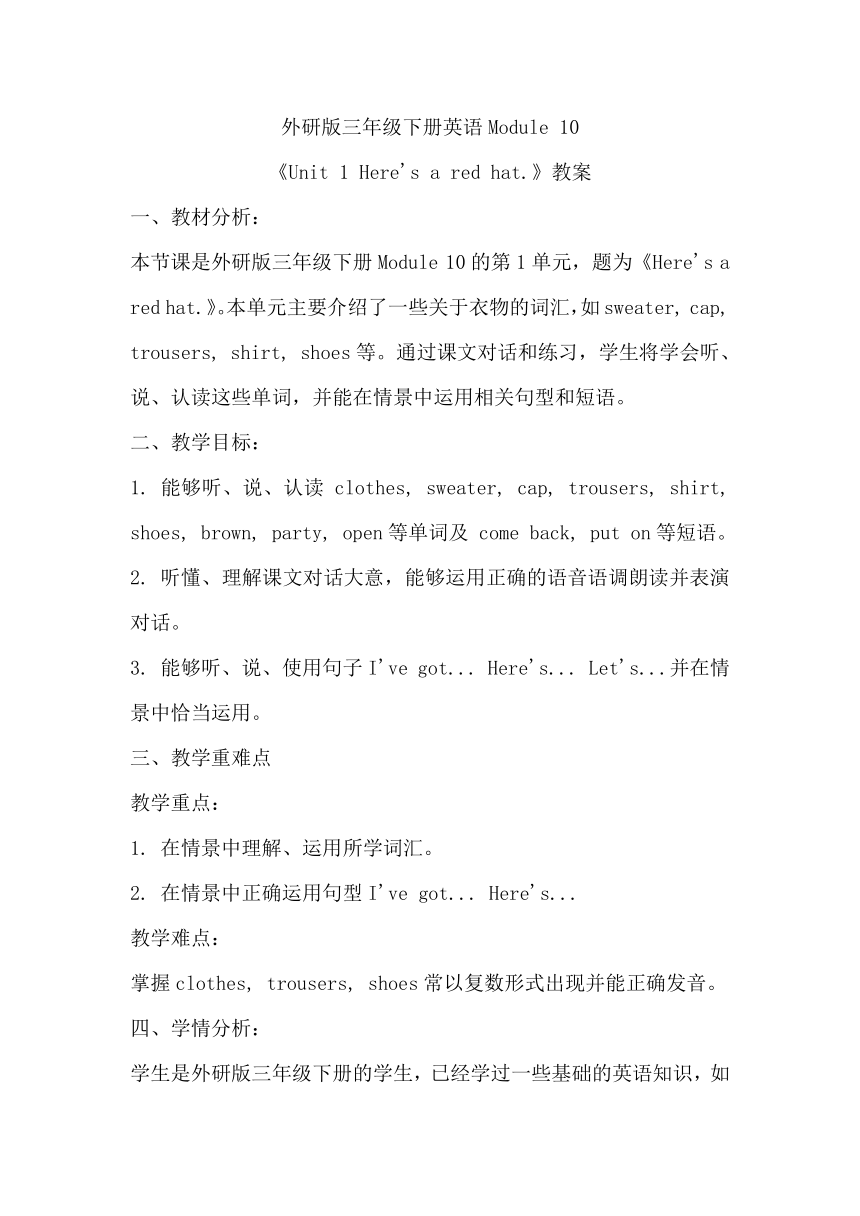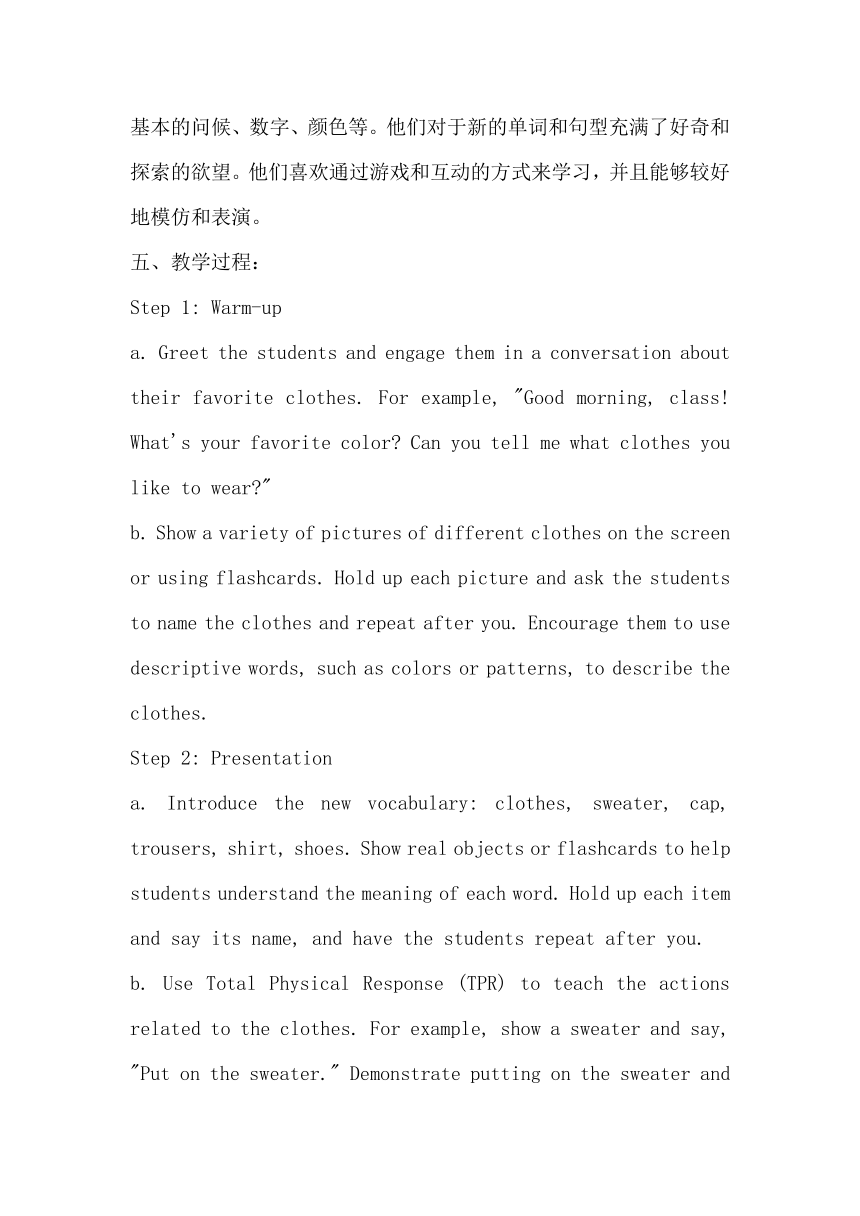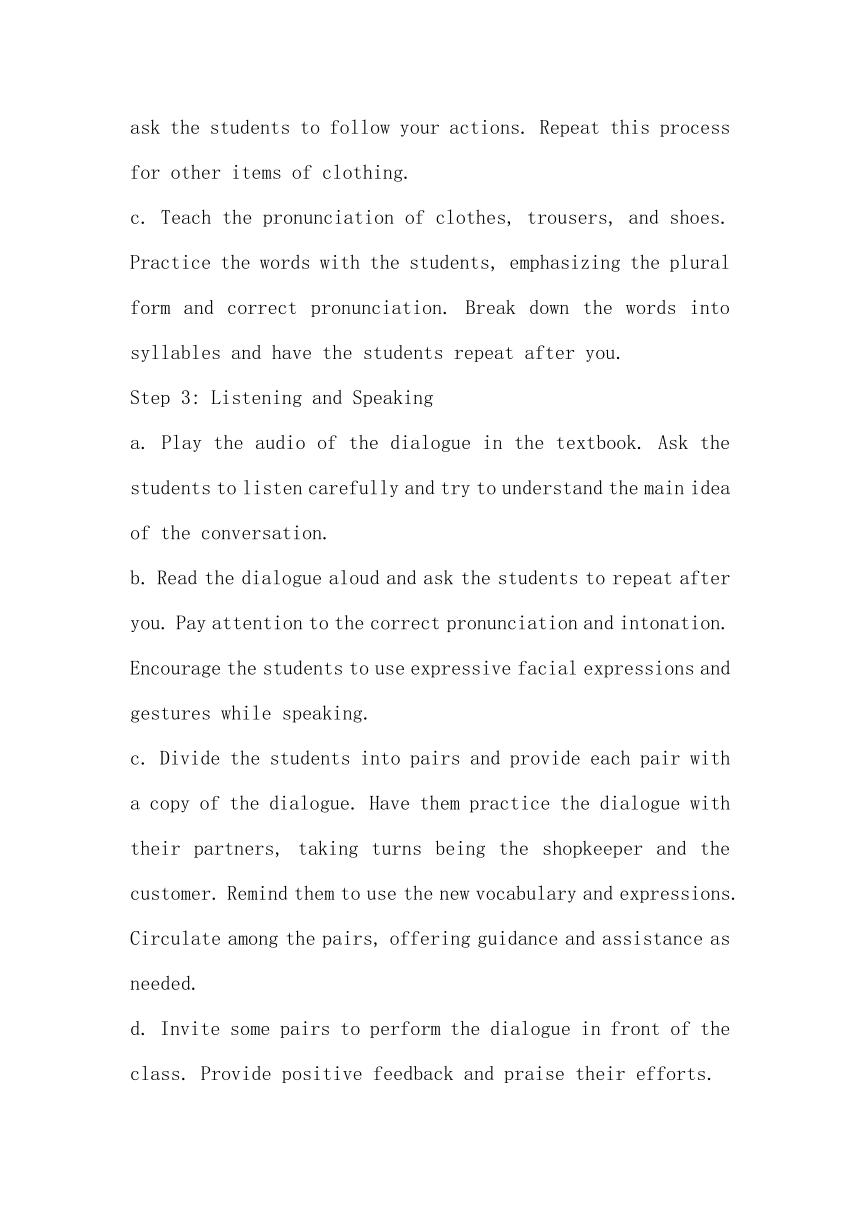Module 10 Unit 1 Here's a red hat. 教案(含反思)
文档属性
| 名称 | Module 10 Unit 1 Here's a red hat. 教案(含反思) |

|
|
| 格式 | docx | ||
| 文件大小 | 14.6KB | ||
| 资源类型 | 教案 | ||
| 版本资源 | 外研版(三年级起点) | ||
| 科目 | 英语 | ||
| 更新时间 | 2024-02-06 11:16:27 | ||
图片预览



文档简介
外研版三年级下册英语Module 10
《Unit 1 Here's a red hat.》教案
一、教材分析:
本节课是外研版三年级下册Module 10的第1单元,题为《Here's a red hat.》。本单元主要介绍了一些关于衣物的词汇,如sweater, cap, trousers, shirt, shoes等。通过课文对话和练习,学生将学会听、说、认读这些单词,并能在情景中运用相关句型和短语。
二、教学目标:
1. 能够听、说、认读 clothes, sweater, cap, trousers, shirt, shoes, brown, party, open等单词及 come back, put on等短语。
2. 听懂、理解课文对话大意,能够运用正确的语音语调朗读并表演对话。
3. 能够听、说、使用句子I've got... Here's... Let's...并在情景中恰当运用。
教学重难点
教学重点:
1. 在情景中理解、运用所学词汇。
2. 在情景中正确运用句型I've got... Here's...
教学难点:
掌握clothes, trousers, shoes常以复数形式出现并能正确发音。
四、学情分析:
学生是外研版三年级下册的学生,已经学过一些基础的英语知识,如基本的问候、数字、颜色等。他们对于新的单词和句型充满了好奇和探索的欲望。他们喜欢通过游戏和互动的方式来学习,并且能够较好地模仿和表演。
五、教学过程:
Step 1: Warm-up
a. Greet the students and engage them in a conversation about their favorite clothes. For example, "Good morning, class! What's your favorite color Can you tell me what clothes you like to wear "
b. Show a variety of pictures of different clothes on the screen or using flashcards. Hold up each picture and ask the students to name the clothes and repeat after you. Encourage them to use descriptive words, such as colors or patterns, to describe the clothes.
Step 2: Presentation
a. Introduce the new vocabulary: clothes, sweater, cap, trousers, shirt, shoes. Show real objects or flashcards to help students understand the meaning of each word. Hold up each item and say its name, and have the students repeat after you.
b. Use Total Physical Response (TPR) to teach the actions related to the clothes. For example, show a sweater and say, "Put on the sweater." Demonstrate putting on the sweater and ask the students to follow your actions. Repeat this process for other items of clothing.
c. Teach the pronunciation of clothes, trousers, and shoes. Practice the words with the students, emphasizing the plural form and correct pronunciation. Break down the words into syllables and have the students repeat after you.
Step 3: Listening and Speaking
a. Play the audio of the dialogue in the textbook. Ask the students to listen carefully and try to understand the main idea of the conversation.
b. Read the dialogue aloud and ask the students to repeat after you. Pay attention to the correct pronunciation and intonation. Encourage the students to use expressive facial expressions and gestures while speaking.
c. Divide the students into pairs and provide each pair with a copy of the dialogue. Have them practice the dialogue with their partners, taking turns being the shopkeeper and the customer. Remind them to use the new vocabulary and expressions. Circulate among the pairs, offering guidance and assistance as needed.
d. Invite some pairs to perform the dialogue in front of the class. Provide positive feedback and praise their efforts.
Step 4: Practice
a. Use flashcards or real objects to create a clothes shop role-play activity. Divide the class into groups of shopkeepers and customers. Provide each group with a set of flashcards or objects representing different clothes.
b. In their groups, the shopkeepers can display the clothes, while the customers ask for specific items using the target language. Encourage the students to use complete sentences, such as "I'd like the red sweater, please" or "Do you have any blue trousers "
c. Monitor the role-play activity and provide assistance and feedback to the students as needed. Encourage them to use the vocabulary and sentences they have learned.
Step 5: Consolidation
a. Review the vocabulary and sentences learned in the lesson by playing a game. For example, divide the class into two teams and show flashcards with different clothes. The teams take turns naming the clothes as quickly as possible. The team with the most correct answers wins.
b. Encourage the students to use the target language during the game and provide positive reinforcement for their efforts. Offer additional explanations or examples if necessary.
Step 6: Wrap-up
a. Summarize the key points of the lesson, emphasizing the new vocabulary and sentences learned. Review the actions related to each item of clothing and ask the students to demonstrate them.
b. Assign homework, which could include practicing the dialogue with a family member or reviewing the vocabulary. Remind the students to bring any questions or difficulties they may have to the next class.
六、板书设计:
Clothes Sweater Cap Trousers Shirt Shoes
I've got... Here's...
Let's...
Come back Put on
七、教学反思:
本节课主要围绕衣物的进行了教学。通过引导学生进行听、说、认读的活动,学生能够掌握并正确使用目标词汇和句型。通过对话的表演和角色扮演活动,学生的口语表达和语音语调有了提高。然而,在教学过程中,我发现学生在发音上还存在一些困难,特别是复数形式的词汇。在以后的教学中,需要更多的练习和巩固,帮助他们掌握正确的发音。此外,教学过程中的游戏和互动活动受到了学生的喜爱,并且有效地激发了他们的学习兴趣。在以后的教学中,可以多设计一些类似的游戏和活动,让学生更加积极主动地参与到课堂中来。
《Unit 1 Here's a red hat.》教案
一、教材分析:
本节课是外研版三年级下册Module 10的第1单元,题为《Here's a red hat.》。本单元主要介绍了一些关于衣物的词汇,如sweater, cap, trousers, shirt, shoes等。通过课文对话和练习,学生将学会听、说、认读这些单词,并能在情景中运用相关句型和短语。
二、教学目标:
1. 能够听、说、认读 clothes, sweater, cap, trousers, shirt, shoes, brown, party, open等单词及 come back, put on等短语。
2. 听懂、理解课文对话大意,能够运用正确的语音语调朗读并表演对话。
3. 能够听、说、使用句子I've got... Here's... Let's...并在情景中恰当运用。
教学重难点
教学重点:
1. 在情景中理解、运用所学词汇。
2. 在情景中正确运用句型I've got... Here's...
教学难点:
掌握clothes, trousers, shoes常以复数形式出现并能正确发音。
四、学情分析:
学生是外研版三年级下册的学生,已经学过一些基础的英语知识,如基本的问候、数字、颜色等。他们对于新的单词和句型充满了好奇和探索的欲望。他们喜欢通过游戏和互动的方式来学习,并且能够较好地模仿和表演。
五、教学过程:
Step 1: Warm-up
a. Greet the students and engage them in a conversation about their favorite clothes. For example, "Good morning, class! What's your favorite color Can you tell me what clothes you like to wear "
b. Show a variety of pictures of different clothes on the screen or using flashcards. Hold up each picture and ask the students to name the clothes and repeat after you. Encourage them to use descriptive words, such as colors or patterns, to describe the clothes.
Step 2: Presentation
a. Introduce the new vocabulary: clothes, sweater, cap, trousers, shirt, shoes. Show real objects or flashcards to help students understand the meaning of each word. Hold up each item and say its name, and have the students repeat after you.
b. Use Total Physical Response (TPR) to teach the actions related to the clothes. For example, show a sweater and say, "Put on the sweater." Demonstrate putting on the sweater and ask the students to follow your actions. Repeat this process for other items of clothing.
c. Teach the pronunciation of clothes, trousers, and shoes. Practice the words with the students, emphasizing the plural form and correct pronunciation. Break down the words into syllables and have the students repeat after you.
Step 3: Listening and Speaking
a. Play the audio of the dialogue in the textbook. Ask the students to listen carefully and try to understand the main idea of the conversation.
b. Read the dialogue aloud and ask the students to repeat after you. Pay attention to the correct pronunciation and intonation. Encourage the students to use expressive facial expressions and gestures while speaking.
c. Divide the students into pairs and provide each pair with a copy of the dialogue. Have them practice the dialogue with their partners, taking turns being the shopkeeper and the customer. Remind them to use the new vocabulary and expressions. Circulate among the pairs, offering guidance and assistance as needed.
d. Invite some pairs to perform the dialogue in front of the class. Provide positive feedback and praise their efforts.
Step 4: Practice
a. Use flashcards or real objects to create a clothes shop role-play activity. Divide the class into groups of shopkeepers and customers. Provide each group with a set of flashcards or objects representing different clothes.
b. In their groups, the shopkeepers can display the clothes, while the customers ask for specific items using the target language. Encourage the students to use complete sentences, such as "I'd like the red sweater, please" or "Do you have any blue trousers "
c. Monitor the role-play activity and provide assistance and feedback to the students as needed. Encourage them to use the vocabulary and sentences they have learned.
Step 5: Consolidation
a. Review the vocabulary and sentences learned in the lesson by playing a game. For example, divide the class into two teams and show flashcards with different clothes. The teams take turns naming the clothes as quickly as possible. The team with the most correct answers wins.
b. Encourage the students to use the target language during the game and provide positive reinforcement for their efforts. Offer additional explanations or examples if necessary.
Step 6: Wrap-up
a. Summarize the key points of the lesson, emphasizing the new vocabulary and sentences learned. Review the actions related to each item of clothing and ask the students to demonstrate them.
b. Assign homework, which could include practicing the dialogue with a family member or reviewing the vocabulary. Remind the students to bring any questions or difficulties they may have to the next class.
六、板书设计:
Clothes Sweater Cap Trousers Shirt Shoes
I've got... Here's...
Let's...
Come back Put on
七、教学反思:
本节课主要围绕衣物的进行了教学。通过引导学生进行听、说、认读的活动,学生能够掌握并正确使用目标词汇和句型。通过对话的表演和角色扮演活动,学生的口语表达和语音语调有了提高。然而,在教学过程中,我发现学生在发音上还存在一些困难,特别是复数形式的词汇。在以后的教学中,需要更多的练习和巩固,帮助他们掌握正确的发音。此外,教学过程中的游戏和互动活动受到了学生的喜爱,并且有效地激发了他们的学习兴趣。在以后的教学中,可以多设计一些类似的游戏和活动,让学生更加积极主动地参与到课堂中来。
同课章节目录
- Module 1
- Unit 1 It's the ABC song.
- Unit 2 My favourite colour is yellow.
- Module 2
- Unit 1 They are monkeys.
- Unit 2 The man is short.
- Module 3
- Unit 1 I like football.
- Unit 2 I don't like riding my bike.
- Module 4
- Unit 1 Do you like meat?
- Unit 2 Does Lingling like oranges?
- Module 5
- Unit 1 She goes to school on Mondays.
- Unit 2 Does your mum go to work on Saturdays?
- Module 6
- Unit 1 What do you do on Sundays?
- Unit 2 What does Lingling have at school?
- Module 7
- Unit 1 We fly kites in spring.
- Unit 2 It's warm today.
- Module 8
- Unit 1 It's on your desk.
- Unit 2 Daming flies a kite in the park.
- Module 9
- Unit 1 I've got a new book.
- Unit 2 Has Amy got a bike?
- Review Module
- Unit 1
- Unit 2
- Module 10
- Unit 1 Here's a red hat.
- Unit 2 She's got an orange sweater.
